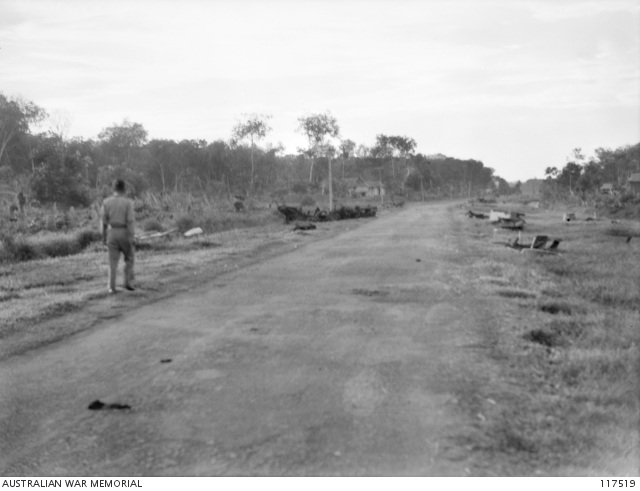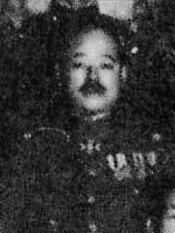Parit Sulong Massacre on:
[Wikipedia]
[Google]
[Amazon]
 On 22 January 1942, the Parit Sulong Massacre in Johor, Malaya (now Malaysia) was committed against Allied soldiers by members of the
On 22 January 1942, the Parit Sulong Massacre in Johor, Malaya (now Malaysia) was committed against Allied soldiers by members of the

 Lt Ben Hackney of the Australian 2/29th Battalion feigned death and managed to escape. He crawled through the countryside for six weeks with two broken legs, before he was recaptured. Hackney survived internment in Japanese POW camps, and was part of the labour force on the notorious Burma Railway. He and two other survivors gave evidence regarding the massacre to Allied war crimes investigators.
The commander of the Imperial Guards, Lt Gen.
Lt Ben Hackney of the Australian 2/29th Battalion feigned death and managed to escape. He crawled through the countryside for six weeks with two broken legs, before he was recaptured. Hackney survived internment in Japanese POW camps, and was part of the labour force on the notorious Burma Railway. He and two other survivors gave evidence regarding the massacre to Allied war crimes investigators.
The commander of the Imperial Guards, Lt Gen.
MacKay's Betrayal: Solving the Mystery of the "Sado Island Prisoner-of-War Massacre" The Journal of Military History - Volume 71, Number 2, April 2007, pp. 441-464
* Mant, Gilbert, 1996, ''Massacre at Parit Sulong'', Kangaroo Press, Kenthurst. * Silver, Lynette, 2004, ''The Bridge at Parit Sulong – An Investigation of Mass Murder'', The Watermark Press, Boorowa. . * Wigmore, Lionel, 1957, ''The Japanese Thrust – Australia in the War of 1939-1945'',
 On 22 January 1942, the Parit Sulong Massacre in Johor, Malaya (now Malaysia) was committed against Allied soldiers by members of the
On 22 January 1942, the Parit Sulong Massacre in Johor, Malaya (now Malaysia) was committed against Allied soldiers by members of the Imperial Guards Division
In Japan, the Imperial Guard is the name for two separate organizations dedicated to the protection of the Emperor of Japan and the Imperial Family, palaces and other imperial properties. The first was the , a quasi-independent elite branch of the ...
of the Imperial Japanese Army
The was the official ground-based armed force of the Empire of Japan from 1868 to 1945. It was controlled by the Imperial Japanese Army General Staff Office and the Ministry of the Army, both of which were nominally subordinate to the Emper ...
. A few days earlier, the Allied troops had ambushed the Japanese near Gemas
Gemas (Negeri Sembilan Malay: ''Gomeh'') is a small town and a mukim in Tampin District, Negeri Sembilan, Malaysia, near the Negeri Sembilan-Johor state border. It is situated 101 km northeast of Seremban, the state capital city, and 30 km no ...
and blown up a bridge there.
Incident
During the Battle of Muar, members of both theAustralian 8th Division
The 8th Division was an infantry division of the Australian Army, formed during World War II as part of the all-volunteer Second Australian Imperial Force. The 8th Division was raised from volunteers for overseas service from July 1940 onwards ...
and the 45th Indian Infantry Brigade
The 45th Indian Infantry Brigade was an Infantry formation of the Indian Army during World War II. The brigade was formed in June 1941, at Ahmednagar in India and assigned to the 17th Indian Infantry Division. It was transferred to Malaya Comman ...
were making a fighting withdrawal, when they became surrounded near the bridge at Parit Sulong. They fought the larger Japanese forces for two days, until they ran low on ammunition and food. Able-bodied soldiers were ordered to disperse into the jungle, the only way they could return to Allied lines. About 150 Australia
Australia, officially the Commonwealth of Australia, is a sovereign country comprising the mainland of the Australian continent, the island of Tasmania, and numerous smaller islands. With an area of , Australia is the largest country by ...
ns and Indians were too seriously injured to move, and their only option was to surrender. Some accounts estimate that as many as 300 Allied troops were taken prisoner at Parit Sulong.
The Imperial Guards kicked and beat the wounded prisoners of war
A prisoner of war (POW) is a person who is held captive by a belligerent power during or immediately after an armed conflict. The earliest recorded usage of the phrase "prisoner of war" dates back to 1610.
Belligerents hold prisoners of w ...
with their rifle butts. At least some of them were tied up with wire in the middle of the road and machine-gunned. The Japanese then poured petrol
Gasoline (; ) or petrol (; ) (see ) is a transparent, petroleum-derived flammable liquid that is used primarily as a fuel in most spark-ignited internal combustion engines (also known as petrol engines). It consists mostly of organic c ...
over the bodies, set them alight, and (in the words of Russell Braddon
Russell Reading Braddon (25 January 1921 – 20 March 1995) was an Australian writer of novels, biographies and TV scripts. His chronicle of his four years as a prisoner of war, '' The Naked Island'', sold more than a million copies.
Braddon ...
) "after their incineration...systematically run over, back and forwards, by Japanese driven trucks." Anecdotal accounts by local people also reported POWs being tied together with wire and forced to stand on a bridge, before a Japanese soldier shot one of them, causing the rest to fall into the Simpang Kiri river and drown.
Aftermath

 Lt Ben Hackney of the Australian 2/29th Battalion feigned death and managed to escape. He crawled through the countryside for six weeks with two broken legs, before he was recaptured. Hackney survived internment in Japanese POW camps, and was part of the labour force on the notorious Burma Railway. He and two other survivors gave evidence regarding the massacre to Allied war crimes investigators.
The commander of the Imperial Guards, Lt Gen.
Lt Ben Hackney of the Australian 2/29th Battalion feigned death and managed to escape. He crawled through the countryside for six weeks with two broken legs, before he was recaptured. Hackney survived internment in Japanese POW camps, and was part of the labour force on the notorious Burma Railway. He and two other survivors gave evidence regarding the massacre to Allied war crimes investigators.
The commander of the Imperial Guards, Lt Gen. Takuma Nishimura
was a Japanese army general in the Imperial Japanese Army during World War II, active in the invasion and occupation of British Malaya. After the Japanese surrender, he was tried and convicted in British Singapore as a war criminal for his r ...
, was later in charge of occupation forces in eastern Singapore
Singapore (), officially the Republic of Singapore, is a sovereign island country and city-state in maritime Southeast Asia. It lies about one degree of latitude () north of the equator, off the southern tip of the Malay Peninsula, bor ...
. He was indirectly involved in the Sook Ching massacre in Singapore. Nishimura retired from the Japanese army in 1942 and was made military Governor of Sumatra
Sumatra is one of the Sunda Islands of western Indonesia. It is the largest island that is fully within Indonesian territory, as well as the sixth-largest island in the world at 473,481 km2 (182,812 mi.2), not including adjacent i ...
. Following the war, he was tried by a British military court in relation to the Sook Ching massacre. Nishimura received a life sentence, of which he served four years. As he returned to Japan, Nishimura was removed from a ship at Hong Kong
Hong Kong ( (US) or (UK); , ), officially the Hong Kong Special Administrative Region of the People's Republic of China (abbr. Hong Kong SAR or HKSAR), is a List of cities in China, city and Special administrative regions of China, special ...
by Australian military police
Military police (MP) are law enforcement agencies connected with, or part of, the military of a state. In wartime operations, the military police may support the main fighting force with force protection, convoy security, screening, rear rec ...
and charged in relation to the Parit Sulong massacre. Nishimura was taken to Manus Island in the Territory of New Guinea
The Territory of New Guinea was an Australian-administered United Nations trust territory on the island of New Guinea from 1914 until 1975. In 1949, the Territory and the Territory of Papua were established in an administrative union by the na ...
, where he faced an Australian military court. Evidence was presented stating that Nishimura had ordered the shootings at Parit Sulong and the destruction of bodies. He was convicted and executed by hanging on 11 June 1951.
In 1996, Australian journalist Ian Ward published ''Snaring the Other Tiger'', which suggested that the Australian Army prosecutor, Captain James Godwin—a former Royal New Zealand Air Force
The Royal New Zealand Air Force (RNZAF) ( mi, Te Tauaarangi o Aotearoa, "The Warriors of the Sky of New Zealand"; previously ', "War Party of the Blue") is the aerial service branch of the New Zealand Defence Force. It was formed from New Zeal ...
pilot who had been ill-treated as a POW in Sumatra—had "manipulated" evidence to implicate Nishimura. Ward states that Godwin took no action on the testimony of Lieutenant Fujita Seizaburo, who reportedly took responsibility for the Parit Sulong massacre. Fujita was not charged and his fate is unknown. Extensive research conducted by Professor Gregory Hadley and James Oglethorpe and published in the ''Journal of Military History'' in 2007 subsequently showed that the evidence that purported to indict James Godwin was a later fabrication created to further political causes in the 1990s.
See also
* List of massacres in MalaysiaFootnotes
References
* Braddon, Russell, 1951, ''The Naked Island'', Penguin Books, Melbourne, * Findlay, Iain, 1991, ''Savage Jungle – An Epic Struggle for Survival'', Simon & Schuster, Sydney.MacKay's Betrayal: Solving the Mystery of the "Sado Island Prisoner-of-War Massacre" The Journal of Military History - Volume 71, Number 2, April 2007, pp. 441-464
* Mant, Gilbert, 1996, ''Massacre at Parit Sulong'', Kangaroo Press, Kenthurst. * Silver, Lynette, 2004, ''The Bridge at Parit Sulong – An Investigation of Mass Murder'', The Watermark Press, Boorowa. . * Wigmore, Lionel, 1957, ''The Japanese Thrust – Australia in the War of 1939-1945'',
AWM AWM may refer to:
*Academies of West Memphis, a public high school in West Memphis, Arkansas
* Appliance Wiring Material, covered by UL standard 758
*Apostolic Women's Ministries, an organization that serves the women of the Apostolic Church of Pent ...
, Canberra.
External links
* {{coord missing, Malaysia Military history of Malaya during World War II Massacres in 1942 1942 in British Malaya Massacres committed by Japan World War II massacres Military history of Australia during World War II 1942 in Japan Mass murder in 1942 January 1942 events Massacres in Malaysia World War II prisoner of war massacres Japanese war crimes